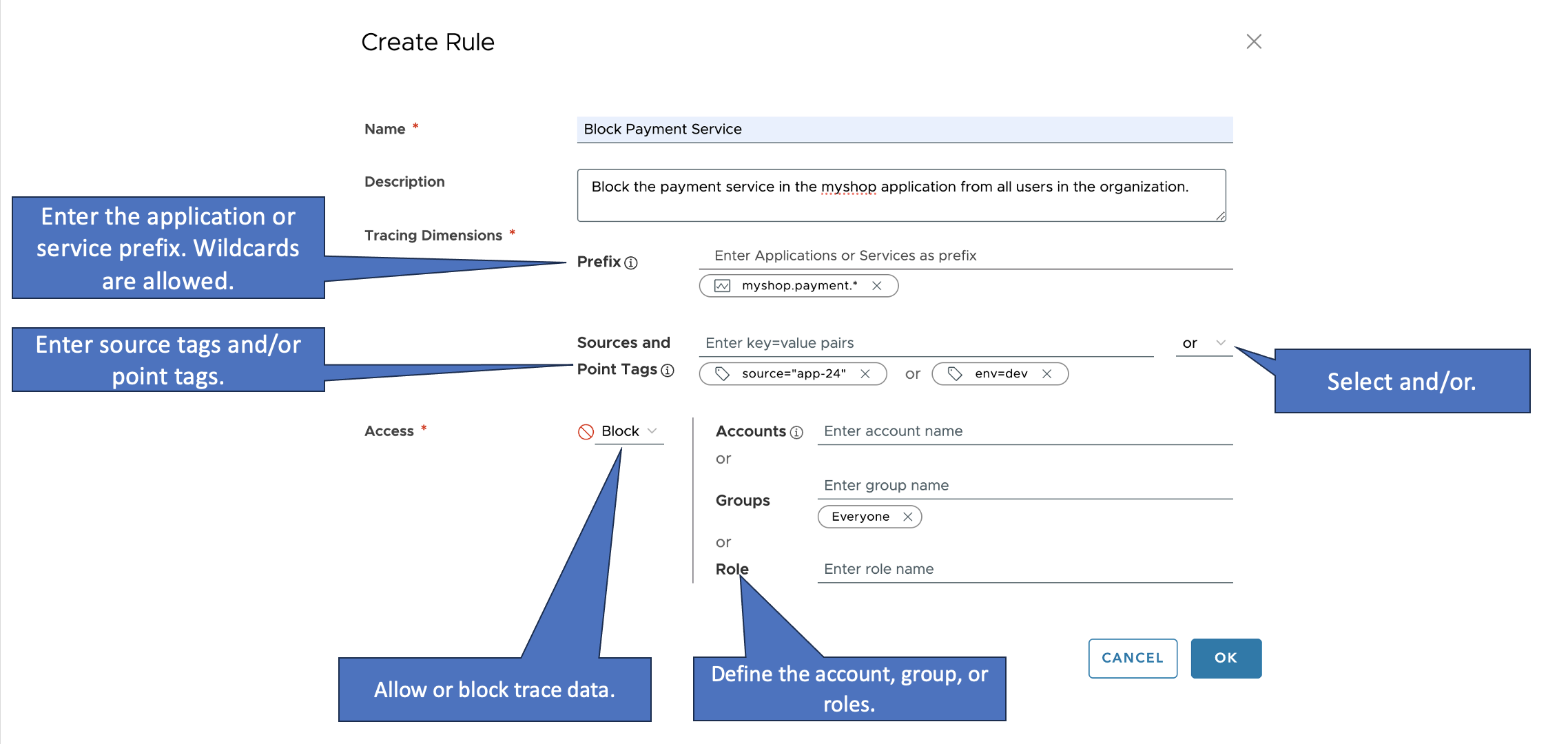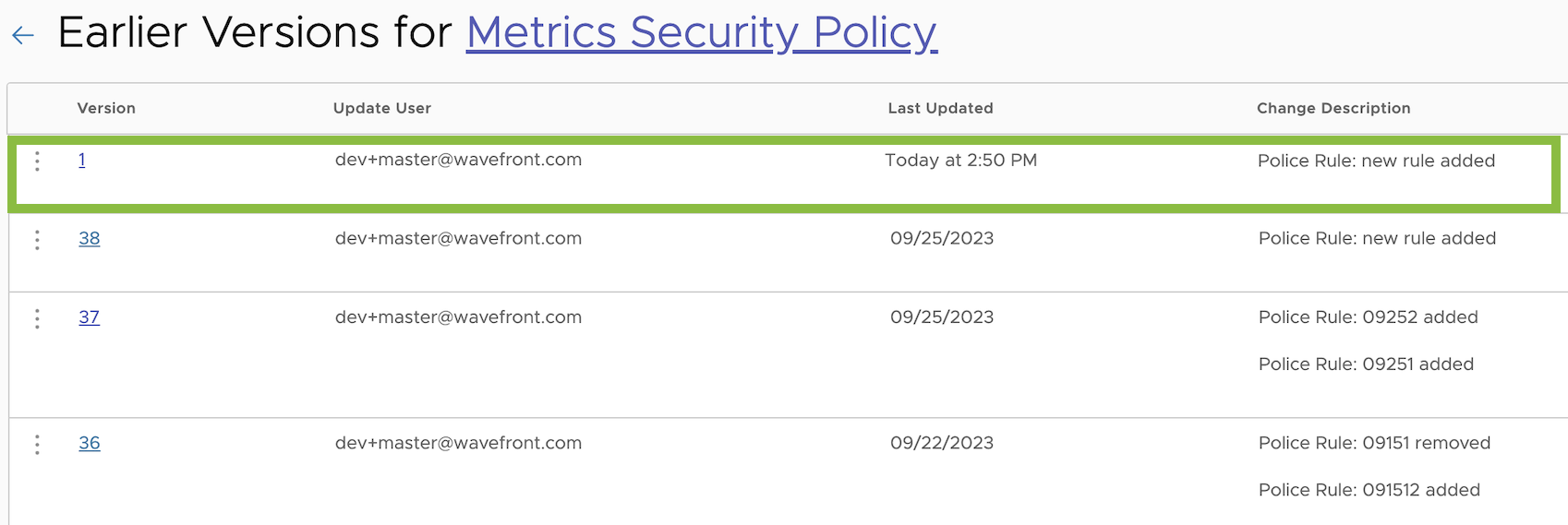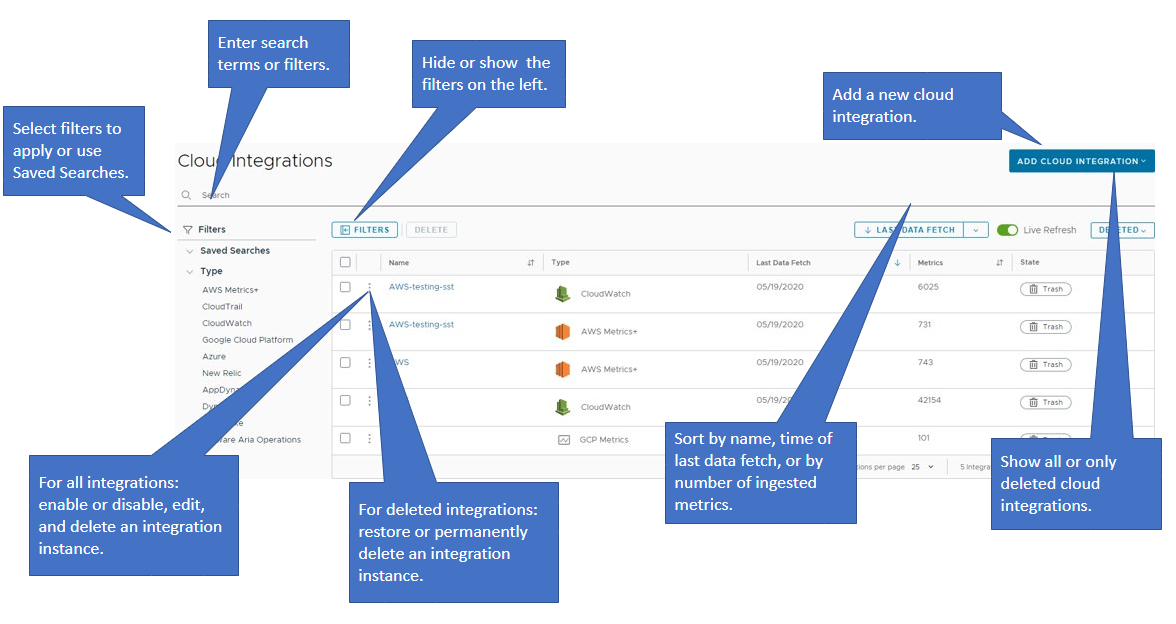These release notes give an overview of the changes for the 2023-31.x to 2023-52.x releases of the Aria Operations for Applications (previously known as Tanzu Observability by Wavefront) service.
2023-52.x Release Notes
Traces Security Policy: You can block application or service information for specific users so that they don’t see the data on the Application Status page, Traces Browser, Application Map, or Operations Dashboards. To learn more, see:
- Traces Security Policies for original and onboarded subscriptions.
- Traces Security Policies for onboarded subscriptions only.
Example: An annotated screenshot of the create traces security policy for original and onboarded subscriptions.

2023-45.x Release Notes
Original and Onboarded Subscriptions
Metrics Security Policy Version History Update: With this release, we move the metrics security policy to a new framework. When you update your metrics security policy:
- The version history is tracked for the new version, and the version history starts from number 1 again. But you don’t lose the previous version history.
Example: In the screenshot below, you have updated the security policy 38 times before this release. When you update the policy after this release, it is numbered as version 1, and you have the older versions listed below it.

- You won’t be able to revert the metrics security policy to the duplicate version number in the old framework because it will be deactivated.
Example: In the screenshot below, you don’t see the vertical ellipsis next to number 1 because it is a duplicate value and a version of the old framework.
2023-40.x Release Notes
Original and Onboarded Subscriptions
Pie Chart Accessibility Improvement: We added the Slice Colors option to the Format tab, so that you can now change the colors of the pie chart slices. See Pie and Donut Chart.
2023-38.x Release Notes
Onboarded Subscriptions
New Admin Permission and Service Role: With this release, we introduce the Admin permission and service role. Admin users can manage the Operations for Applications organization settings.
Original and Onboarded Subscriptions
Cloud Integrations Page Improvements: We improved the user experience of the Cloud Integrations page. To navigate to this page:
- In your service instance, click Integrations on the toolbar.
- Click a cloud integration tile, for example Amazon Web Services.
- On the Setup tab, click Advanced.

On the Cloud Integrations page, now you can:
- Apply various filters and hide or show the filters listed on the left.
- Search for integrations, save and share searches.
- Hide or show the filters on the left.
- Click the Add Cloud Integration button and select a new integration to add.
- Select to display all active or only the deleted integrations.
- Sort the cloud integrations by name, time of the last data fetch, or number of ingested metrics.
- Use the ellipsis icon menu to:
- Enable or disable an integration instance, edit it, or delete it, when all integrations are displayed.
- Restore an integration instance or select to permanently delete it, when only deleted integrations are displayed.
2023-34.x Release Notes
Original and Onboarded Subscriptions
Kubernetes Alerts Templates: We included new alerts templates for the Kubernetes integration. See the Integrations Release Notes for details.
2023-33.x Release Notes
Original and Onboarded Subscriptions
-
Alerts Improvements: When the Resolve Window for an alert is deleted by using an external tool, in the Operations for Applications UI, the Alert will now properly display that the Resolve Window matches the Trigger Window.
-
Sources Browser Page Improvements: The Sources browser page is now improved and allows you to:
- Hide and show details for all sources or for a specific source.
- Apply various filters and hide or show the filters listed on the left.
- Hide a single source or create a maintenance window for the alerts with a particular source.
In addition, the page on which you can examine a single source is also improved for better user experience.
2023-31.x Release Notes
Original and Onboarded Subscriptions
- Logs GA release: With this release, we launch the General Availability of our Logs feature. You can:
- Send your logs to our service, and troubleshoot using the Logs Browser.
- Create logs charts to view logs next to your metrics data.
- Drill into logs from alerts, charts, and traces.
- Customize the default log settings to map logs tags to metrics and trace tags so you can drill into logs seamlessly.
Important: Logs is enabled only for selected customers. If you want to participate, contact your account representative or technical support.
-
Logs Alerts: You can create alerts for your logs data and see the firing events of the logs alert. See Manage Logs Alerts for details.
Note:- You need the Logs permission to view the logs alerts.
- You need the Alerts and Logs permissions to create and manage logs alerts.
The steps to add roles and permissions differ for onboarded and original subscriptions. For details, see how to manage roles, groups, and permissions for onboarded subscriptions and original subscriptions.
In this release, you can create logs alerts only when the default query language for your user account is WQL and Chart Builder is the default way for building queries. This limitation will be removed in an upcoming release.

-
Maintenance Window Browser Page Improvements: The Maintenance Window browser page is now improved and allows you to:
- Hide and show details for all maintenance windows or for a specific maintenance window.
- Sort the maintenance windows by name, state, start or end time.
- Apply various filters and hide or show the filters listed on the left.
-
New Field in the Generic Webhook Alert Template: We added the
contributingKVsiterator, which returns the keys and values of each source and point tag used in the time series of a failed alert whose condition uses a single top-level aggregation function.Important: This feature is not available by default. To enable this feature for your service instance, contact your account representative or technical support. - Support for Alerting on ~alert.webhooks: With this release, you can alert on
cs(~alert.webhooks.*). See Query Responses of Webhook Alert Targets for details.
Onboarded Subscriptions Only
-
Support for Kubernetes Integration Setup: We added support for setting up the Kubernetes integration when your Operations for Applications service is onboarded to VMware Cloud services. See the Integrations Release Notes for details.
-
Support for Tanzu Application Service Integration Setup: We added support for setting up the Tanzu Application Service integration when your Operations for Applications service is onboarded to VMware Cloud services. See the Integrations Release Notes for details.